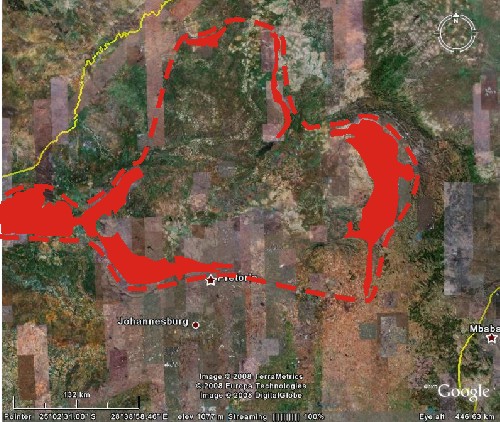We’ve established that the differentiated mineral unit that I showed you yesterday is part of a larger, slow cooling intrusive igneous body. More specifically, it it found within the imaginatively named ‘Upper Zone’ of the Rustenburg Layered Suite, which is also exactly what it says on the tin: a fairly substantial sequence of compositionally layered igneous rocks. To see just how substantial, we’re going to have to step back a little:

The Rustenburg Suite, which reaches thicknesses of almost 9 kilometres in places, is but one part of the larger Bushveld Igneous Complex (pdf): prior to the intrusion of the layered unit about 2 billion years ago, up to 3km of basalts were erupted at the surface, and a granitic body was intruded a little bit later. The total weight of all of this dense volcanic rock appears to have bowed down the crust in the centre of the intrusion, causing everything to dip inwards – including the very hard quartzites beneath the lower contact of the intrusion. These baked sediments form the prominent ridges you can see running around the edges of the Rustenburg outcrop (particularly along the southeastern and western boundaries).
The scale of the layering that we were looking at yesterday seems rather insignificant in a formation that you can quite easily see from space. However, the fact that our magnetite layer is sitting on top of several kilometres’ worth of olivine and pyroxene-rich igneous rocks at least partially explains the weird magmatic chemistry that Kim was wondering about – all of the other minerals that should be forming along with magnetite and plagioclase have been removed from the melt already. Oh, and the chromite, too:




Comments (1)